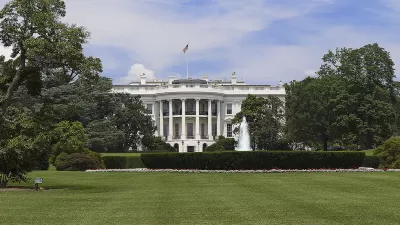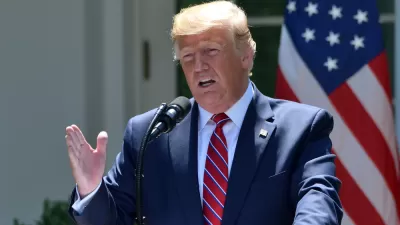President Trump wants states to reopen businesses quickly but doesn't want to have the Centers for Disease Control and Prevention provide directions to business owners and transit agencies on how to open without spreading the coronavirus.

The 17-page guidance prepared by CDC, titled “Guidance for Implementing the Opening Up America Again Framework," was intended to be released on May 1, but was intentionally buried by the Trump administration. A CDC official told AP reporters Jason Dearen and Mike Stobbe that the document “would never see the light of day." The draft guidelines were sent to the White House last month.
The guidance was to meant to provide details to restaurant owners, churches, transit operators, daycare operators, et. al, on how to open safely, for both workers and customers. It was a follow-up to the White House – CDC guidance, released April 16, titled “Opening Up America Again, also known as "gating criteria", that set metrics that needed to be met before businesses could actually open.
For example, guidance for "Interim Guidance for Mass Transit Administrators" (pg. 15), states:
Mass transit is critical for many Americans to commute to and from work and to access essential goods and services. This
guidance provides considerations for mass transit administrators to maintain healthy business operations and a safe and
healthy work environment for employees, while reducing the risk of COVID-19 spread for both employees and passengers.Ensure social distancing (pg. 16)
- Institute measures to physically separate or create distance of at least six feet between all occupants. This may include:
- Asking bus passengers to enter and exit the bus through rear doors, while allowing exceptions for persons with disabilities.
- Closing every other row of seats.
- Reducing maximum occupancy of buses and individual subway and train cars and increasing service on crowded routes as appropriate.
Public health experts are very concerned, if not alarmed, by the intentional silencing of the nation's public health agency.
“CDC has always been the public health agency Americans turn to in a time of crisis,” said Dr. Howard Koh, a Harvard professor and former health official in the Obama administration during the H1N1 swine flu pandemic in 2009. “The standard in a crisis is to turn to them for the latest data and latest guidance and the latest press briefing. That has not occurred, and everyone sees that.”
The silencing of CDC fits a pattern where the administration wants to ensure that the responsibility for handling the pandemic falls in the hands of "the governors," illustrated by Trump's claim on April 27 that "the federal government should act as the 'supplier of last resort' for the [coronavirus diagnostic] tests as it works with states to ramp up a testing regime that health experts say is necessary before a national reopening," as reported by CNN.
The federal guidance was meant to assist state departments of public health as they work with businesses in their states to provide for safe environments for workers and customers.
“States and local health departments do need guidance on a lot of the challenges around the decision to reopen,” said Dr. Marcus Plescia, chief medical officer of the Association of State and Territorial Health Officials. “You can say that restaurants can open and you need to follow social distancing guidelines. But restaurants want to know, ‘What does that look like?’”
Maggie Haberman and Abby Goodnough of The New York Times report that "White House and other administration officials rejected the recommendations over concerns that they were overly prescriptive, infringed on religious rights and risked further damaging an economy that Mr. Trump was banking on to recover quickly."
"The C.D.C.’s director, Dr. Robert R. Redfield, and other leaders of the agency have had almost no public platform during the pandemic," they add. The two public health experts who have become familiar to Americans watching the briefings by the White House Coronavirus Task Force are Dr. Deborah L. Birx, an infectious diseases expert and Dr. Anthony S. Fauci, the longtime director of the National Institute of Allergy and Infectious Diseases.
This week, the White House signaled it would wind down its coronavirus task force only to reverse course amid a public outcry.
The rejection of the C.D.C.’s guidelines for reopening is the latest confusing signal as the Trump administration struggles to balance the president’s desire to quickly reopen the country against the advice of public health experts, who have counseled reopening methodically through a series of steps tied to reduced rates of infection and expanded efforts to control the spread of the coronavirus.
"A CDC spokesperson said the agency is working with all 50 states and providing recommendations and guidance on how to respond to the virus, including best practices for reopening," reports Brianna Ehley for POLITICO. "It is unclear if or when the agency will release revised formal guidelines for businesses and other establishments."
Related in Planetizen:
- President Trump's Plan to Reopen the Economy Rests with States, April 20, 2020
FULL STORY: Trump administration buries detailed CDC advice on reopening

Trump Administration Could Effectively End Housing Voucher Program
Federal officials are eyeing major cuts to the Section 8 program that helps millions of low-income households pay rent.

Planetizen Federal Action Tracker
A weekly monitor of how Trump’s orders and actions are impacting planners and planning in America.

Ken Jennings Launches Transit Web Series
The Jeopardy champ wants you to ride public transit.

Philadelphia Is Expanding its Network of Roundabouts
Roundabouts are widely shown to decrease traffic speed, reduce congestion, and improve efficiency.

Why Bike Lanes Are Good: An Explainer for the US Transportation Secretary
Sean Duffy says there’s no evidence that bike lanes have benefits. Streetsblog — and federal agencies’ own data — beg to differ.

California Invests Additional $5M in Electric School Buses
The state wants to electrify all of its school bus fleets by 2035.
Urban Design for Planners 1: Software Tools
This six-course series explores essential urban design concepts using open source software and equips planners with the tools they need to participate fully in the urban design process.
Planning for Universal Design
Learn the tools for implementing Universal Design in planning regulations.
Ada County Highway District
Clanton & Associates, Inc.
Jessamine County Fiscal Court
Institute for Housing and Urban Development Studies (IHS)
City of Grandview
Harvard GSD Executive Education
Toledo-Lucas County Plan Commissions
Salt Lake City
NYU Wagner Graduate School of Public Service





























